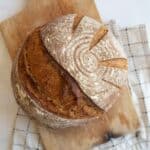Sourdough Rye Bread
If you’re looking for a rich, flavorful bread with an earthy tang, sourdough rye bread is the perfect choice. This bread brings together the deep flavor of rye, the heartiness of whole wheat, and the tangy character of a well-developed sourdough starter.
Servings: 1 large loaf
Ingredients
- 1 1/4 cups water (300 grams)
- 1 cup sourdough starter (200 grams)
- 1 cup rye flour (140 grams)
- 1/4 cup whole wheat flour (35 grams)
- 2 cups bread flour + ½ cup if needed (270 grams + up to an additional 70 grams)
- 1 1/2 teaspoons salt (9 grams)
- 1 tablespoon molasses (21 grams)
- 2 teaspoons caraway seeds optional
Instructions
Prepare the sourdough starter:
- Feed your sourdough starter 4-12 hours before making the dough to ensure it is active and bubbly.
Mix the dough:
- In the bowl of your stand mixer, combine the water and sourdough starter. Add the rye flour, whole wheat flour, 2 cups of the bread flour (reserving the remaining ½ cup), salt, molasses, and caraway seeds (if using). Turn the mixer on low and mix well to combine.
- Continue to mix on low to medium-low speed for 5 minutes.
- After 5 minutes, add the additional remaining bread flour, 1 tablespoon at a time, until the dough is soft but not sticky. Only add flour as needed; you may not need it all.
- Mix in the stand mixer for an additional 3 to 5 minutes until a smooth and elastic dough comes together.
Bulk fermentation:
- Remove the dough from the bowl of your stand mixer and put it in a heavy ceramic or glass bowl. Cover the dough with a damp towel, plastic wrap, or beeswax wrap and allow it to bulk-ferment at room temperature until doubled in size, about 12 to 18 hours.
Shape the dough:
- Gently remove the dough from the bowl. Using your hands, gently pull the dough ball towards you, letting its grip on the counter pull it into a tighter ball. Rotate the dough slightly and repeat around the edges until you’ve formed a tight ball.
- Prepare a bread-proofing basket by dusting it well with flour (if it’s new, you’ll need to season it by spraying it with a little water and then adding the flour so it sticks), or use a medium mixing bowl (about 8 inches across). To prepare the mixing bowl, you’ll want to coat it generously with cooking spray and then flour very well, or you can line it with a kitchen towel and dust it very well with flour.
- Place your dough ball, smooth top down, into your prepared basket or bowl, and cover with a damp towel.
Proof the dough:
- Let the dough rest for 1 to 4 hours at room temperature or until it’s spread out a bit and looks puffy.
- Preheat the oven to 450 degrees F.
Score and bake:
- Gently turn your bread dough onto a piece of parchment paper. (I like to put my parchment paper on top of a thin cutting board, put the paper and board on top of my bread basket, and turn it over gently).
- Remove the dough from the bowl. Score the top with a lame or sharp knife.
- Use the corners of the parchment paper to lift the dough into your Dutch oven. Place the lid on the Dutch oven.
- Place the Dutch oven in the hot oven and cook for 40 minutes.
- Remove the lid and put the Dutch oven back in the oven, uncovered, for another 10-15 minutes.
- The bread will be dark and sound hollow when tapped when it is done.
Cool:
- Remove the pan from the oven, remove the bread from the pan, and let it cool on a wire rack for 1 hour before slicing and serving.
- Sourdough bread is best eaten the day of, though leftovers make great toast or grilled sandwiches.
Notes
- Molasses adds a slight sweetness and depth to the rye bread, balancing out the earthy flavor of the rye flour.
- Optional but highly recommended! Caraway seeds add a classic rye flavor that enhances the overall taste of the bread.
- If your home is cooler, allow more time for bulk fermentation. In warmer homes, the process will be faster. The rising times can also be adjusted to fit your schedule. Make the sourdough work for you and not the other way around.
- You can replace the whole wheat flour with additional rye flour if you’d like.
Nutrition
Calories: 757kcal | Carbohydrates: 163g | Protein: 22g | Fat: 4g | Saturated Fat: 0.3g | Polyunsaturated Fat: 1g | Monounsaturated Fat: 1g | Sodium: 3517mg | Potassium: 837mg | Fiber: 18g | Sugar: 16g | Vitamin A: 17IU | Vitamin C: 1mg | Calcium: 114mg | Iron: 5mg
QR code
Scan this QR code with your phone's camera to view this recipe on your mobile device.
